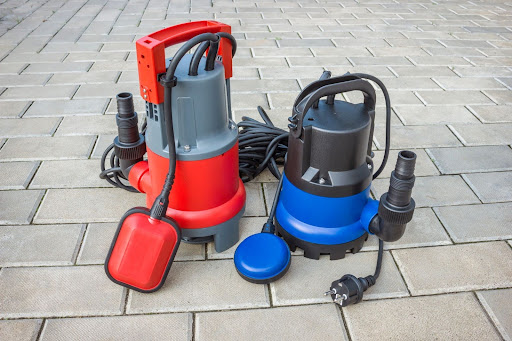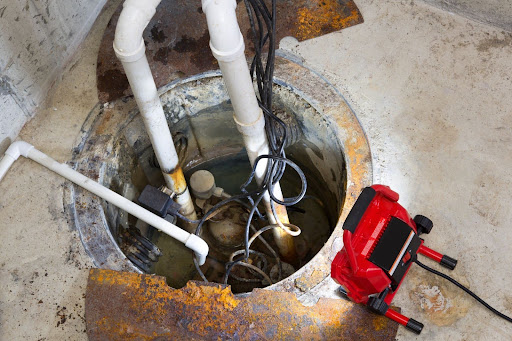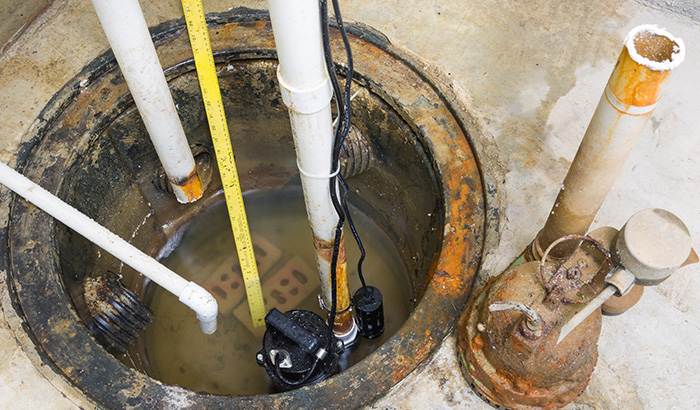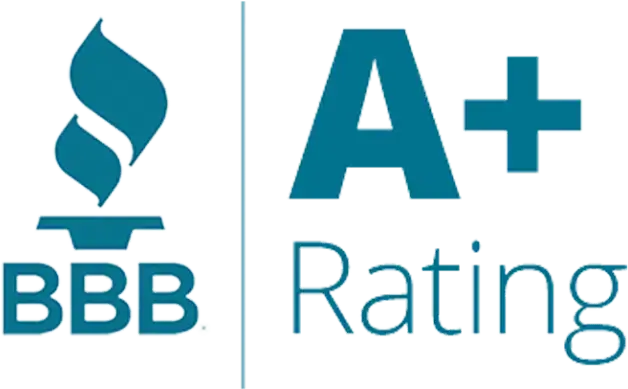In the heart of every home that battles against the relentless challenge of water intrusion lies a silent guardian: the sump pump. This unsung hero, often tucked away in the basement, plays a crucial role in maintaining a dry and healthy living environment. A sump pump works quietly to ensure your home is resilient against potential water damage.
But what happens when this machine falters? The consequences of a malfunctioning sump pump can be far-reaching. Flood prevention isn’t just about avoiding the inconvenience of water in your basement; it’s also about safeguarding your home’s foundation.
When considering whether or not to replace your sump pump, we invite you to ask yourself five critical questions. These questions will help you assess the state of your sump pump. Let’s explore whether it’s time for your sump pump to pass the baton to a new pump.
1. How old is your current sump pump?
Knowing the age of your sump pump helps you anticipate potential issues. Typically, a sump pump has a lifespan of about seven to 10 years. However, each sump pump’s life can vary based on usage, maintenance, and environmental factors.
As your sump pump ages, it may begin to show signs of its age. These signs can be subtle, like an occasional unusual noise, or more overt, like a noticeable decrease in efficiency. It’s crucial to pay attention to these changes. A sump pump losing its vigor may struggle to keep up during heavy rainfalls or rapid snow melts — situations where it has a critical role.
Imagine a scenario where a heavy storm hits, and your aging sump pump can no longer keep up with the influx of water. The result could be a flooded basement, damaged property, and a disrupted life. Therefore, assessing the age and condition of your sump pump is not just a routine check; it’s a proactive step toward ensuring your home remains a safe haven. If your sump pump is nearing or has surpassed the decade mark, it may be time to consider a replacement.
Getting a new or more efficient sump pump is an investment in your home’s lifespan. Let’s ensure your sump pump is ready to stand guard when the skies open, keeping your home dry and your worries at bay.
2. Have you noticed any unusual noises or operations?
Much like your home’s pipes, your sump pump is a crucial component of your household’s plumbing system. It’s essential to know the signs that your sump pump may be experiencing issues. Not addressing these issues can lead to more significant problems.
Unusual noises or operations from your sump pump are indicators of potential malfunctions that require immediate attention.
A grinding or rattling noise from your sump pump could signify motor issues, possibly due to wear and tear or a blockage in the system. This kind of noise should not be ignored, as it indicates that the sump pump may be on its way to a complete breakdown.
Similarly, a loud banging noise, especially at the end of the pumping cycle, might indicate a problem with the check valve. This valve is essential for preventing the backflow of water, and any issues here can compromise the efficiency of your sump pump.
Operational issues are equally important to note. If your sump pump runs non-stop, this could be a sign of a malfunctioning switch or an improperly sized pump for your needs. On the other hand, a pump that fails to activate during high water levels is a serious concern, pointing to potential issues with the float mechanism or the power supply.
It’s crucial to address these signs of trouble as soon as they are noticed. Ignoring them can lead to significant water damage, especially during periods of heavy rainfall.

3. Is your sump pump pit clean and well-maintained?
The sump pump pit is integral to your home’s flood prevention system, acting as the first line of defense against water damage. Keeping your sump pump pit clean and well-maintained is a simple yet effective way to ensure your home stays dry and protected.
Just like the pipes in your home, the sump pump pit requires regular maintenance to ensure optimal performance. A well-maintained sump pump pit enhances the efficiency of your sump pump and extends its lifespan.
Firstly, it’s essential to keep the pit free from debris. Over time, items like dirt, leaves, or small stones can accumulate in the pit, potentially clogging the pump and hindering its ability to function correctly. Regular inspections and cleaning of the pit can prevent these blockages. Check the pit at least once a year or more frequently if you live in an area prone to heavy rains or flooding.
Another critical aspect of maintenance is checking for any signs of structural damage to the pit itself. Cracks or damage can allow soil to enter the pit, which can then clog the pump and pipes. If you notice any structural issues, it’s important to address them promptly to prevent further complications.
Additionally, ensure that the walls of the pit or debris do not hinder the sump pump’s float switch. The float switch is crucial for the automatic activation of the pump, and any obstruction can lead to a failure in operation, especially during critical times of high water levels.
Lastly, consider the installation of a sump pump cover. This can help reduce the amount of debris entering the pit and minimize moisture and odors emanating from the pit. A cover can also prevent small animals or insects from getting into the system, which can cause blockages or damage.
4. Have you experienced any flooding recently?
Experiencing flooding in your home can be a clear indicator that your sump pump may not be functioning as effectively as it should. Much like how corroded pipes can lead to unexpected leaks, a failing sump pump can be the hidden culprit behind water intrusion in your basement or crawl space. Even minor flooding incidents can signal significant issues with your sump pump system.
If you’ve recently faced flooding, the first step is to assess the extent of the damage. Water stains on the walls, damp flooring, or a musty odor can all point to the severity of the flooding. Consider the frequency of these incidents. Recurrent flooding, even if minor, suggests a persistent issue with your sump pump that requires attention.
After a flooding event, inspect your sump pump for any obvious signs of malfunction, such as a stuck float switch, a clogged intake, or an unresponsive motor. However, some issues may not be immediately apparent. In such cases, it’s wise to consult with a professional plumber who can conduct a thorough evaluation of your sump pump system.
Take proactive measures to prevent future flooding. This could involve servicing or replacing your existing sump pump. Remember, promptly addressing these issues can save you from the hassle and expense of repeated flood damage.

5. Are you prepared for Increased water flow challenges?
Over time, weather patterns change. Some decades get more rain than others, for example. Sometimes, weather patterns change from year to year. Just as we adapt our homes to withstand various weather conditions, it’s essential to ensure that your sump pump is equipped to handle these changes.
The key to preparedness lies in understanding the capacity of your current sump pump and assessing whether it’s sufficient to manage rainfall in your area. An overwhelmed sump pump can lead to the very issue it’s meant to prevent — flooding. This is particularly important if you’ve noticed changes in your area’s weather patterns, such as more intense storms or prolonged periods of rain.
Consider a sump pump with a higher capacity or installing a backup system for added security. A backup sump pump, especially one with a battery backup, can be a lifesaver during power outages, which often accompany severe weather events. Additionally, regular maintenance and checks become even more vital in ensuring your sump pump is always ready to perform when needed.
Remember, being prepared is not just about responding to the challenges; it’s about staying one step ahead.
Let Pando Plumbing answer all your sump pump questions
Your home’s safety and comfort hinges on your sump pump’s reliability. Just as you trust the structural integrity of your home to keep you safe, placing your trust in a dependable sump pump system is essential for effective flood prevention and peace of mind. It’s not just about dealing with the water you can see; it’s about preventing the damage you can’t.
At Pando Plumbing, we understand the critical role of a sump pump in your home. That’s why we emphasize the importance of having a functional sump pump and ensuring that it’s the right fit for your specific needs.
Whether it’s assessing the age and condition of your current system, addressing unusual noises or operations, maintaining the sump pump pit, recovering from recent flooding, or preparing for increased water flow challenges, our team is here to provide expert guidance and solutions.
Contact Pando Plumbing for a comprehensive assessment of your sump pump system. Our experienced professionals are equipped to provide the best advice and services tailored to your unique situation.
Don’t wait for the next big storm to test the limits of your sump pump. Take proactive steps today to ensure your home remains the dry, safe haven it’s meant to be. Remember, when it comes to protecting your home from water damage, the right preparation makes all the difference.




